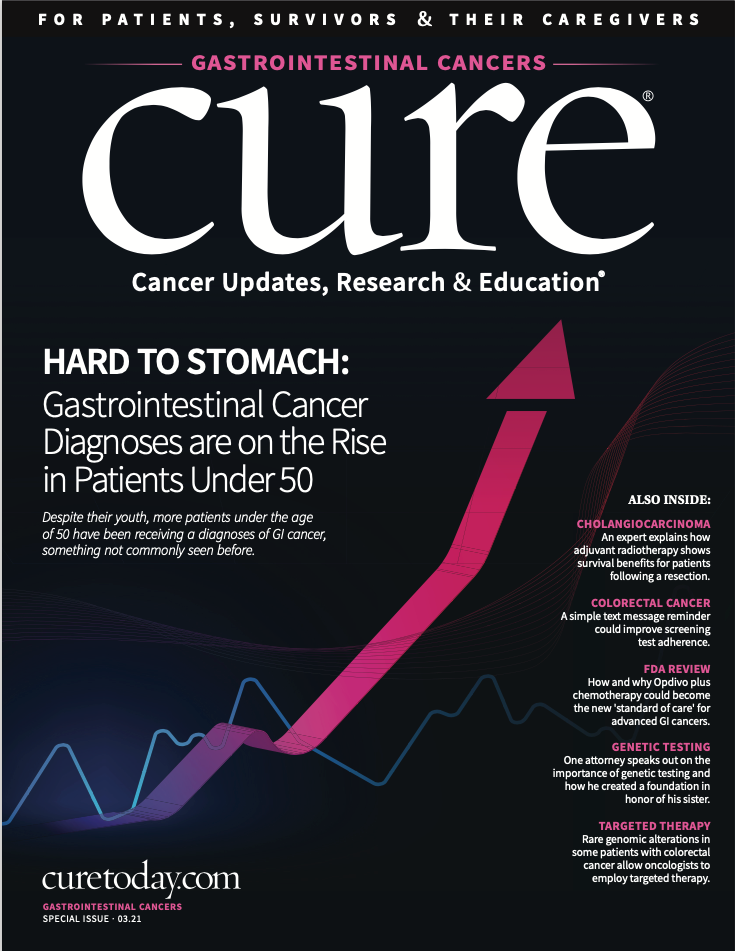Publication
Article
CURE
Opdivo with Chemotherapy Treatment Under Priority Review by FDA Shows Promise for Patients with Advanced Gastrointestinal Cancers
Author(s):
In clinical trials, Opdivo in combination with chemotherapy improved overall survival and progression-free survival compared to chemotherapy alone.
In December 2020, the Food and Drug Administration (FDA) granted priority review to Opdivo (nivolumab) in combination with chemotherapy for treatment of several gastrointestinal cancers based on results from the phase 3 CheckMate649 trial, which showed that Opdivo and chemotherapy improved progression-free survival and overall survival.
The FDA is expected to make a decision on Opdivo in combination with chemotherapy by May 25.
To learn more about why this treatment has been granted priority review and what an approval could mean for patients, CURE® interviewed Dr. Michael Pishvaian, associate professor at John Hopkins School of Medicine and director of Gastrointestinal, Developmental Therapeutics and Clinical Research Programs at Sidney Kimmel Comprehensive Cancer Center at John Hopkins in Washington D.C.
CURE®: What does it mean when the FDA grants a priority review?
Pishvaian: Generally speaking, (when) a new therapy is looking highly promising and there (are) some preliminary data that (suggest) it might actually be effective for patients, the FDA wants to be able to get it out to patients as quickly as possible so (they’re) not missing an opportunity. That’s part of the expedited review process ... but ultimately the (drug developer) will need to present the full set of data and, in some cases, even follow up with a more definitive trial (before) the FDA gives ... final approval.
Would you explain why this particular therapy was granted priority review?
Two big studies were presented at the European Society for Medical Oncology Virtual Congress last fall. One was CheckMate649, which was a trial of Opdivo with chemotherapy versus chemotherapy alone in patients with gastric and esophageal cancers. Interestingly, and in some ways surprisingly, the addition of Opdivo to chemotherapy improved patient survival, including overall and progression-free survival.
This is a pretty big change because some previous studies had mixed results with either Opdivo or its cousin Keytruda (pembrolizumab). But (CheckMate649) was a larger and more definitive study that did clearly show a survival benefit. So ... I think everybody’s predicting that the treatment will get FDA (approval for use in patients with advanced or metastatic gastric cancer, gastroesophageal junction cancer or esophageal adenocarcinoma).
What would this mean for patients?
It means that patients are going to be able to have this drug added on to their chemotherapy regimen. We know that chemotherapy definitely improves survival, at least compared with a placebo, in patients with advanced, metastatic stage 4 gastric and esophageal cancers. The standard chemotherapies have become a doublet, as we call it — two drugs. Typically, a (fluoruracil) drug (plus) a second drug that (is a platinum-based compound). These doublet therapies have proved (beneficial) to patients.
This was the first trial that showed that if you add the immunotherapy — Opdivo in this case — it actually improved survival. Our goals when trying to treat patients who (have) incurable cancers — unfortunately, these patients fall into that category — is to help them live longer ... and to do so in a way that maintains (as high a) quality of life as possible. This trial definitely showed that the addition of Opdivo (helped patients live longer).
How could this change clinical practice?
It really arguably should be the standard of care to receive Opdivo in addition to chemotherapy for any patient with advanced esophageal cancer.
Are there any side effects that patients should be mindful of?
The immunotherapies have been around for 10 or more years, so we’ve learned a lot about them because (they’re) very commonly used and the side effects have become predictable; we know roughly what percentage of patients are at risk (for side effects).
(Approximately) 70% to 80% of patients have no side effects. About 10% to 15% of patients have moderate side effects, but they aren’t typically chemotherapy-like side effects. When we think of chemo, we think of nausea, vomiting, diarrhea, extreme fatigue and hair loss. These immunotherapy side effects are (cold/flu-like) side effects. I always tell patients that if you think of when you had the flu, those are the kinds of symptoms you experience: fevers, chills, muscle aches and pains, joint aches and pains, and a rash can develop.
Then about 10% of patients can have an autoimmune reaction, which is basically when the immune system is revved up so much that it starts to attack the normal, healthy parts of the body. There can be an autoimmune suppression of some of the hormone-producing glands, such as the thyroid gland and the adrenal gland.
Then finally, importantly, about 3% of patients on these drugs can have very serious autoimmune reactions (in which) the body starts to attack, for example, the lungs or the liver — so autoimmune pneumonitis, that’s lung toxicity, or autoimmune hepatitis, which is liver toxicity. Really ... any organ can be affected by an autoimmune reaction, but those are the two more common serious reactions.
I tell patients (that) 10 years ago, when these drugs were first coming out, (the 3% of patients who developed these life-threatening) side effects ... did die because of (them). We learned very quickly how to suppress the severity of the side effects. Typically, we can reverse the side effects fairly quickly by giving steroids or other immune inhibitors and shutting down the immune system. Now, thankfully, most patients do not die from the side effects, even though 3% of them can still get very severe side effects.
For more news on cancer updates, research and education, don’t forget to subscribe to CURE®’s newsletters here.





